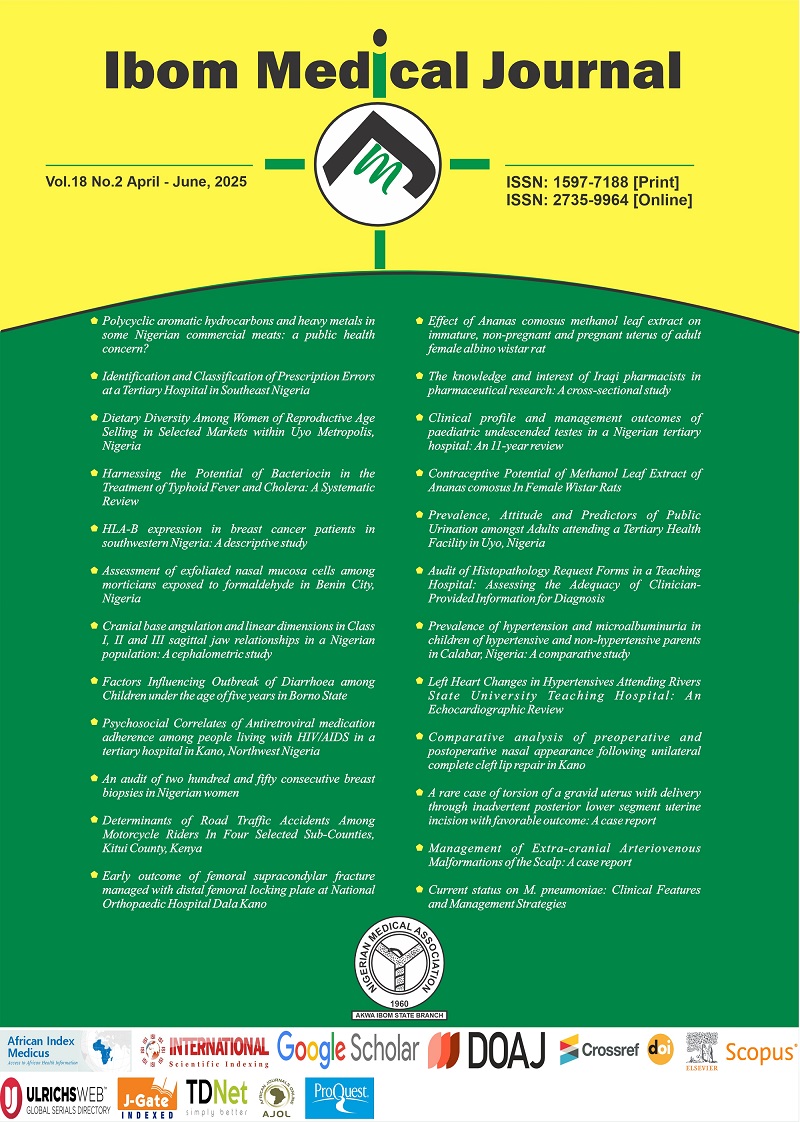Prevalence, Attitude and Predictors of Public Urination amongst Adults attending a Tertiary Health Facility in Uyo, Nigeria
DOI:
https://doi.org/10.61386/imj.v18i2.675Keywords:
public urination, adults, Uyo, NigeriaAbstract
Background: Public urination is a widespread sanitation challenge and public health concern with global occurrence and regional variation. Despite its prevalence, empirical data on its determinants and public attitudes remain limited, particularly in low-resource settings. This study aimed to assess the prevalence of public urination, examine public attitudes toward the practice, and identify socio-demographic and behavioural predictors of public urination among adults in Uyo, Nigeria.
Methods: A descriptive cross-sectional study was conducted among 361 adults attending the General Outpatient Clinic at the University of Uyo Teaching Hospital, Nigeria, between September 1 and October 31, 2019. Data were collected using a structured questionnaire and analysed using Statistical Package for the Social Sciences (SPSS) Statistics version 17.0. Descriptive statistics summarized socio-demographic and behavioural characteristics and urination practices, while chi-square tests assessed associations between categorical variables. Statistical significance was set at p-value <0.05. Logistic regression was employed to determine independent predictors of public urination and attitudes toward the practice, adjusting for potential confounders. Odds ratios and 95% confidence intervals were generated.
Results: Public urination was highly prevalent, with 78.7% of respondents reporting the behaviour in the past six months. The most cited reasons for public urination were poor sanitary conditions of available toilets (46.8%) and the absence of public toilets (39.4%). A negative attitude toward public urination was reported by 80.9% of respondents, with women significantly more likely than men to disapprove of the practice (86.7% vs. 71.8%, p=0.001). In multivariable analysis, women were twice as likely as men to have a negative attitude toward public urination (aOR=2.00, 95% CI: 1.11–3.67, p=0.02), while rural residents had lower odds of negative attitudes compared to urban residents (aOR=0.45, 95% CI: 0.22–0.75, p=0.004). Employment in the private sector was associated with a higher likelihood of public urination (aOR=2.10, 95% CI: 1.10–3.90, p=0.02). Conversely, being married (aOR=0.48, 95% CI: 0.26–0.90, p=0.02) and having a negative perception of public urination (aOR=0.27, 95% CI: 0.10–0.71, p=0.008) were associated with lower odds of engaging in the behaviour.
Conclusion: Public urination is a common practice in the study area, largely driven by inadequate sanitation infrastructure. While public disapproval of the behaviour is high, systemic barriers contribute to its persistence. Addressing this issue requires investment in public sanitation facilities, policy enforcement, and behavioural interventions to promote proper hygiene practices.
Downloads
Published
License
Copyright (c) 2025 Ekanem AM, Akwaowo CD, Motilewa OO, Udofia EA, Eduwem DU, Akpanekpo E

This work is licensed under a Creative Commons Attribution 4.0 International License.










